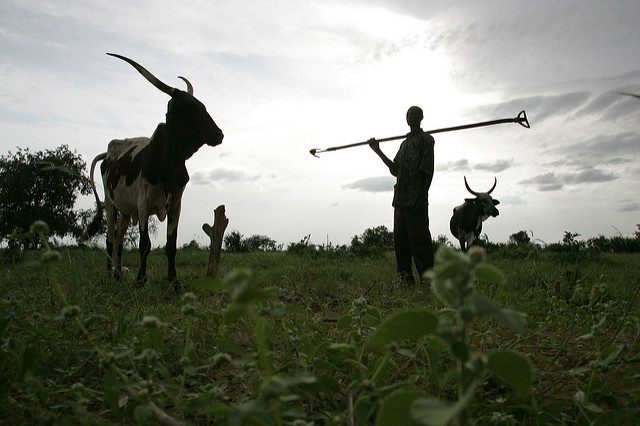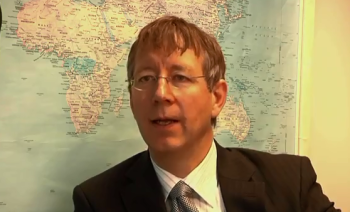The EU‘s longstanding partnership with UN agencies – including the Food and Agriculture Organization – has allowed for marked successes, including the eradication of a virulent livestock disease and the development of global forest mapping technology.
We sat down with Willem Olthof, First Counsellor to the EU Delegation in Rome, to look back over 10 years of EU-FAO collaboration.
The EU Delegation to the Holy See, the Order of Malta, the UN Organisations in Rome, and to the Republic of San Marino works closely with the three Rome-based UN agencies – addressing issues of food, agriculture, and rural development.
Each organisation is adapted to its own purpose – with the EU working (broadly) with the Food and Agriculture Organisation (FAO) on standard setting and good practices in agriculture, fisheries and forestry, the World Food Programme (WFP) on emergencies, and the International Fund for Agricultural Development (IFAD) on rural development.
“The EU share in these organisations is pretty big, with the EU and its Member States providing about 40-45% of the budget of these organisations,” explained Willem Olthof, First Counsellor-Development Adviser at the Delegation. “As an EU Delegation we liaise closely with these organisations; and in the case of FAO, we’re also involved in its governance.”
“Essentially, we are using UN organisations to advance European priorities and to jointly work on global priorities that are on the agenda of the UN and that are shared by the EU,” said Olthof.
“The FAO’s strength is that you can combine a normative element with development work”
EU-FAO cooperation
This engagement is especially marked with the FAO. From 2007 to 2017, the EU provided upwards of EUR 1.5 billion to FAO programmes, according to a recent report on EU-FAO Cooperation.
Most of the funding has gone towards development priorities, with DG DEVCO alone responsible for 80% of the funding and for coordination between the various Directorates-General involved in FAO's work (AGRI, CLIMA, ECHO, ENV, MARE, RTD, SANTE, TRADE). Overall, the EU signs on average one project contract every week. “There’s a huge variety – the size and duration of these projects differ a lot.”
The EU’s engagement with the FAO plays off their complementarities, explained Olthof. FAO’s mandate bridges setting soft law, providing guidelines and good practices for the Organisation's 194 members, and assisting with capacity development, with much of the EU funding going to the later.
“The FAO’s strength is that you can combine a normative element with development work,” Olthof said. “That’s one of the lessons we’ve learned.”
Long-term results
Engagement with the FAO is part of the daily work of the Delegation, Olthof said, referring to the strategic direction of the organisation, its normative (standard setting) work and cooperation in the form of concrete projects. Giving the example of land rights – which require the inclusion of many stakeholders and a long process of dialogue – Olthof underlined that the strength of cooperation lays in sustained engagement. “To achieve long term results you have to be in the game for a long time, and the study clearly shows this,” he said.

The elimination of cattle plague is estimated to have averted an annual loss of almost 1 billion USD in Africa alone © ILRI/Stevie Mann
One of the clearest examples given in the report is the eradication of rinderpest. Also known as ‘cattle plague’, rinderpest was a highly deadly viral disease affecting domesticated and non-domesticated species.
The disease, which spread from Europe to Africa in the early 20th century, was finally eliminated in 2011 – averting the annual loss of almost 1 billion USD in Africa alone.
The EU played a fundamental role in this success, by cooperating with the FAO on strengthening the veterinary services of affected countries, providing long term financial support and engaging actively with partner governments.
“It’s the first time that [the elimination of an animal disease] has happened, and could only be done through years and years of commitment and support,” said Olthof.
Keeping up the dialogue
The report further underlines the need to maintain an active dialogue in order to achieve success in projects. “It’s not just a matter of handing over a project, it’s a matter of jointly getting into it,” Olthof said. “It’s seldom something where we just provide money; you need to work in partnership with the FAO, governments, the private sector, and civil society.”
Food security information systems provide a good example of a cooperation success driven by this philosophy. EU-FAO collaboration on developing reporting systems on food insecurity – from the number of people affected, to the degree of severity – is one such case. The systems have allowed for the collection of more up-to-date and reliable information, in turn allowing for a better allocation of resources.
“Many of the really important long term successes depend on the fact that you create partnerships”
“It’s also a matter of exchanging information and vision through discussions,” Olthof said, stressing the necessity of choosing partners who bring their own expertise. “Many of the really important long term successes depend on the fact that you create partnerships.”
The FIRST initiative (Food and Nutrition Security Impact, Resilience, Sustainability and Transformation), Olthof said, is a good way of demonstrating how systematic partnerships can work beyond funding.
“[The initiative] boils down to providing policy support to countries through long-term FAO policy officers, who are placed within ministries of partner countries,” Olthof explained. The officer’s role is determined through discussions held between the partner country, the FAO, and the EU, with the scope of work chosen based on joint priorities.
Providing for the public good
Olthof further mentioned the work the EU’s partnership with FAO, along with the European Commission’s Joint Research Centre and the Directorate-General for the Environment, has done on sustainable forestry and forest resource assessments.
As part of the partnership, FAO keeps track of global deforestation, and how forests are changing. According to Olthof, “FAO’s publications here are a reference for policy making around the world.”
|
Find out more about the FIRST project here:
|
While assessments have traditionally been conducted within countries – following standard methodologies – the development and application of satellite technology with EU’s collaboration and financing has allowed for the collection of more precise data. “These assessments are now much better and much faster, so in a sense we have helped to provide a global public good,” Olthof said.
The EU-FAO partnership report provides a host of other case studies, from the EU’s engagement on desertification prevention to combating illegal fishing, but is limited to projects financed at the European level through the European Development Fund and the European Budget.
“The idea is that this report triggers more dialogue with FAO, but also with our Member States and partner countries,” Olthof said.
The hope, he added, is to continue learning from the successes of the partnership. “Because, of course, we use FAO as an instrument to create a more sustainable planet,” he said.
Image credit: Maciek Lulko/Flickr via Creative Commons license 2.0
This article was written by Craig Hill, Journalist and Content Editor at Capacity4dev






Log in with your EU Login account to post or comment on the platform.